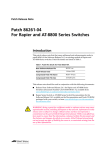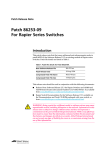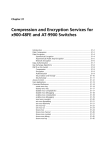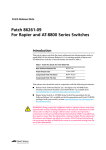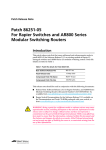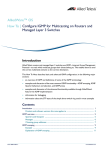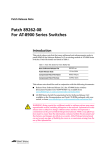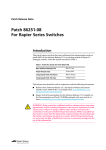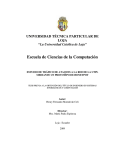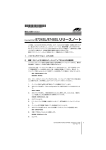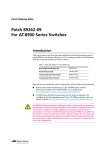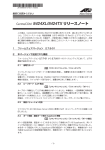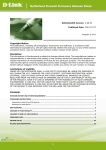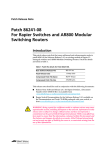Download Release Notes for Patch 86253-07
Transcript
Patch Release Note
Patch 86253-07
For Rapier Series Switches
Introduction
This patch release note lists the issues addressed and enhancements made in
patch 86253-07 for Software Release 2.5.3 on existing models of Rapier series
switches. Patch file details are listed in Table 1.
Table 1: Patch file details for Patch 86253-07.
Base Software Release File
86s-253.rez
Patch Release Date
18-Feb-2004
Compressed Patch File Name
86253-07.paz
Compressed Patch File Size
333756 bytes
This release note should be read in conjunction with the following documents:
■
Release Note: Software Release 2.5.3 for Rapier Switches and AR400 and
AR700 Series Routers (Document Number C613-10362-00 Rev A) available
from www.alliedtelesyn.co.nz/documentation/documentation.html.
■
Rapier Switch Documentation Set for Software Release 2.5.1 available on
the Documentation and Tools CD-ROM packaged with your switch, or
from www.alliedtelesyn.co.nz/documentation/documentation.html.
WARNING: Using a patch for a different model or software release may cause
unpredictable results, including disruption to the network. Information in this
release note is subject to change without notice and does not represent a
commitment on the part of Allied Telesyn International. While every effort has
been made to ensure that the information contained within this document and
the features and changes described are accurate, Allied Telesyn International
can not accept any type of liability for errors in, or omissions arising from the
use of this information.
Simply connecting the world
2
Patch Release Note
Some of the issues addressed in this Release Note include a level number. This
number reflects the importance of the issue that has been resolved. The levels
are:
Level 1
This issue will cause significant interruption to network services, and
there is no work-around.
Level 2
This issue will cause interruption to network service, however there
is a work-around.
Level 3
This issue will seldom appear, and will cause minor inconvenience.
Level 4
This issue represents a cosmetic change and does not affect network
operation.
Features in 86253-07
Patch 86253-06 was not released.
Patch 86253-07 includes all issues resolved and enhancements released in
previous patches for Software Release 2.5.3, and the following enhancements:
PCR: 03941
Module: FIREWALL
Level: 2
TCP Keepalive packets for FTP sessions were passing through the firewall
during the TCP setup stage with TCP Setup Proxy enabled. Keepalive
packets include sequence numbers that have already been acknowledged.
Such packets now fail stateful inspections and are dropped by the FTP
application-level gateway.
PCR: 03961
Module: PIM, PIM6
Level: 2
The PIM-DM prune expiry time was not reset when a State Refresh message
was received. This issue has been resolved.
PCR: 03997
Module: IPG
Level: 3
When policy-based routing was active, IP packets not matching any policyspecific routes were forwarded, even if there was no default policy route.
This issue has been resolved. Now, a route whose policy exactly matches the
policy of the packet is selected. If an exact match does not exist, a route with
the default policy will be used to route the packet. If no route is found, the
packet is discarded. The TOS field in incoming IP packets is ignored, so
packets with the TOS value set are forwarded using a route with the default
policy.
PCR: 31080
Module: IPv6
Level: 2
When a ping was sent to the device’s link-local address, the device flooded
the ICMP Reply packet over the VLAN. This issue has been resolved.
PCR: 31104
Module: OSPF
Level: 2
Occasionally when a device rebooted its OSPF routes were missing from the
route table. This issue has been resolved.
Patch 86253-07 for Software Release 2.5.3
C613-10382-00 REV E
Patch 86253-07 For Rapier Series Switches
PCR: 31160
3
Module: IPG
Level: 2
A memory leak occurred if DNS relay was configured, and the device kept
receiving DNS Query packets. This issue has been resolved.
PCR: 31176
Module: PIM6
Level: 2
PIM6 could not send unicast bootstrap messages to a new neighbour. This
issue has been resolved.
PCR: 31178
Module: FIREWALL
Level: 4
If the SMTP Proxy detected a third party relay attack, the “SMTP third
party relay attack” trigger message was not displayed. This issue has
been resolved.
PCR: 31200
Module: SWI
Level: 2
The forwarding database table sometimes did not update correctly when
multiple packets with the same MAC source address were sent to the switch
via different ports. This issue has been resolved.
PCR: 31202
Module: QOS
Level: 3
The HWQUEUE parameter in the SET QOS HWQUEUE command
incorrectly accepted values from 0 to 9999. The upper limit for this
parameter is 3. This issue has been resolved. The correct limit is now
enforced.
PCR: 31205
Module: VRRP
Level: 3
Two VRRP log messages were displayed when they should not have been.
The log messages were:
Vrrp 1: Vlan vlan2 10 Port Failed decrementing priority by 20
Vrrp 1: Vlan vlan2 1 Port up incrementing priority by 2
This issue has been resolved. These messages are now displayed at the
correct time.
PCR: 31220
Module: OSPF
Level: 2
OSPF neighbours did not establish the Full state when IP route filters were
applied. This issue has been resolved.
PCR: 31223
Module: IPV6
Level: 3
The neighbour discovery timeout has been set to 3 seconds in ICMPv6 to
speed up Destination Unreachable detection.
PCR: 31224
Module: IPG
Level: 3
The badQuery and badRouterMsg counters in the SHOW IGMP and SHOW
IGMPSNOOPING commands were not incrementing correctly. This issue
has been resolved.
PCR: 31230
Module: OSPF
Level: 3
When an Inter-area route went down and the only other route to the
destination was an AS-External route, the AS-External route was not
selected. This issue has been resolved.
Patch 86253-07 for Software Release 2.5.3
C613-10382-00 REV E
4
Patch Release Note
PCR: 31233
Module: L3F
Level: 2
A filter entry was lost when the SET SWITCH L3FILTER ENTRY command
did not succeed. This issue has been resolved.
PCR: 31236
Module: IPV6
Level: 3
Link-local addresses can only be unicast addresses. If a link-local address
was added as an anycast address, no error message was returned. This issue
has been resolved. Now, an error message is returned stating that a linklocal address must be a unicast address.
PCR: 31239
Module: IPV6
Level: 3
The Maximum Transmission Unit (MTU) was not always set to the MTU
value in the ICMP Packet Too Big Message sent from the device. This issue
has been resolved.
PCR: 31247
Module: VLAN, IPG
Level: 2
After IGMP snooping was disabled, multicast data was not flooded to
VLANs. This was because the multicast route forwarding port map was
cleared. This issue has been resolved.
PCR: 31253
Module: SWI, SW56
Level: 2
The forwarding database table sometimes did not update correctly when
multiple packets with the same MAC source address were sent to the switch
via different ports. This issue has been resolved.
PCR: 31258
Module: IPG, DHCP
If DHCP clients do not respond to echo requests, the DHCP server can not
detect an addressing conflict, so may offer inuse addresses to clients. This
issue has been resolved.
This PCR introduces a new parameter, PROBE, to the CREATE DHCP
RANGE and SET DHCP RANGE commands. This parameter allows for
address probing using ARP requests and replies instead of the normal ping
mechanism. This feature is limited to clients on the same subnet (broadcast
domain) as the DHCP server, and therefore can not be used with the
GATEWAY parameter.
The new syntax is:
CREATE DHCP RANGE=name [PROBE={ARP|ICMP}]
[other-parameters]
SET DHPC RANGE [PROBE={ARP|ICMP}] [other-parameters]
PCR: 31259
Module: DHCP
Level: 2
When the DHCP server rejected a DHCPRequest message, the requested IP
address was not logged correctly. This issue has been resolved.
PCR: 31268
Module: IPG
Level: 2
PCR 31128 introduced an issue that occasionally caused a fatal error with IP
flows. This issue has been resolved.
Patch 86253-07 for Software Release 2.5.3
C613-10382-00 REV E
Patch 86253-07 For Rapier Series Switches
PCR: 31270
5
Module: CURE, IPG, ATK,
DVMRP, IPX2, LB, LOG, SNMP,
UTILITY
Level: 3
Entering “?” after a command at the CLI gives context-sensitive Help about
parameters valid for the command. Occasionally, commands (for example,
ENABLE IP MULTICASTING) were executed when “?” was entered at the
end of the command. This issue has been resolved.
PCR: 40006
Module: LOG
Level: 2
Executing the SHOW DEBUG command caused a fatal error if the
temporary log had been destroyed with the DESTROY LOG
OUTPUT=TEMPORARY command. This issue has been resolved.
PCR: 40007
Module: FIREWALL
Level: 2
When an interface-based enhanced NAT was defined in a firewall policy,
and a reverse NAT rule was defined to redirect traffic to a proxy server, the
reverse NAT did not work correctly. The proxy server did not receive any
traffic from the device. This issue has been resolved.
PCR: 40008
Module: NTP
Level: 3
When the device operated in NTP Client mode, the SHOW TIME command
sometimes displayed the incorrect time. This issue has been resolved.
PCR: 40012
Module: IPG, OSPF
Level: 2
The device sometimes rebooted when OSPF on demand was enabled for
PPP. This issue has been resolved.
PCR: 40020
Module: SW56
Level: 3
When a port’s ingress limit was set to less than 1000 with the
INGRESSLIMIT parameter in the SET SWITCH PORT command, sending
packets to a tagged port caused FCS errors on transmission. This issue has
been resolved.
PCR: 40023
Module: IPG
Level: 2
The timeout interval for IGMP group membership now conforms to RFC
2236 for IGMPv2.
PCR: 40038
Module: OSPF
Level: 2
After a Summary LSA for the default route in a stub area had been refreshed
by an Area Border Router, and the Area Border Router was restarted, the
Summary LSA was not advertised into the stub area again. This issue has
been resolved.
Patch 86253-07 for Software Release 2.5.3
C613-10382-00 REV E
6
Patch Release Note
Features in 86253-05
Patch file details are listed in Table 2:
Table 2: Patch file details for Patch 86253-05.
Base Software Release File
86s-253.rez
Patch Release Date
26-November-2003
Compressed Patch File Name
86253-05.paz
Compressed Patch File Size
700793 bytes
Patch 86253-05 includes all issues resolved and enhancements released in
previous patches for Software Release 2.5.3, and the following enhancements:
PCR: 03781
Module: STP
Level: 2
A buffer leak occurred when rapid STP was specified with the SET STP
MODE=RAPID command, but STP had not been enabled with the ENABLE
STP command. This issue has been resolved.
PCR: 03861
Module: IPV6
Level: 2
When a connector was plugged into one physical interface, the RIPng
request packet was erroneously transmitted from all interfaces on the
switch. This issue has been resolved.
PCR: 03873
Module: IPG
Level: 4
The STATIC and INTERFACE options have been removed from the
PROTOCOL parameter in the ADD IP ROUTE FILTER and SET IP ROUTE
FILTER commands. These parameters were redundant because received
static and interface routes are always added to the route table.
PCR: 03905
Module: TTY
Level: 3
A fatal error occurred in the text editor while selecting blocks and scrolling
up. This issue has been resolved.
PCR: 03910
Module: IPG
Level: 3
When RIP demand mode was enabled, and one interface changed to a
reachable state, the triggered Request packet was not sent from that
interface, and triggered Response packets were not sent from all other RIP
interfaces. This resulted in slow convergence of routing tables across the
network. This issue has been resolved.
PCR: 03926
Module: PIM
Level: 2
Repeated Assert messages were sent after the prune limit expired. This issue
has been resolved. The default dense mode prune hold time has been
changed from 60 seconds to 210 seconds.
PCR: 03940
Module: PKI
Level: 1
The following two issues have been resolved:
•
Large CRL files were not decoded correctly.
•
The certificate database was not validated immediately after the CRL
file was updated.
Patch 86253-07 for Software Release 2.5.3
C613-10382-00 REV E
Patch 86253-07 For Rapier Series Switches
PCR: 03953
7
Module: SW56
Level: 3
On AT-8800 series switches, strict QoS scheduling is now enforced for ports
where egress rate limiting is applied. On Rapier i series switches, the same
QoS setup is now applied to all of the appropriate ports when setting up
egress rate limiting.
PCR: 03970
Module: IPV6
Level: 3
If an IPv6 filter that blocked traffic on a VLAN interface was removed, the
traffic was still blocked. This issue has been resolved.
PCR: 03982
Module: FIREWALL
Level: 3
The SMTP proxy did not correctly filter sessions where messages were
fragmented. This had the potential to prevent the detection of third-party
relay attacks. This issue has been resolved.
PCR: 03993
Module: FIREWALL
Level: 4
The AUTHENTICATION parameter has been removed from the “?” CLI
help for firewall commands. This was not a valid parameter.
PCR: 03996
Module: FIREWALL
Level: 2
Occasionally some firewall timers stopped early, resulting in sessions being
removed prematurely. Because of this, TCP Reset packets could be sent by
the firewall before TCP sessions were finished. This issue has been resolved.
PCR: 03997
Module: IPG
Level: 3
When policy-based routing was active, IP packets not matching any policyspecific routes were forwarded, even if there was no default policy route.
This issue has been resolved. Now, a route whose policy exactly matches the
policy of the packet is selected. If an exact match does not exist, a route with
the default policy will be used to route the packet. If no route is found, the
packet is discarded. The TOS field in incoming IP packets is ignored, so
packets with the TOS value set are forwarded using a route with the default
policy.
PCR: 31002
Module: UTILITY
Level: 2
Sometimes the device rebooted when a severe multicast storm occurred due
to a loop in the network. This issue has been resolved.
PCR: 31004
Module: TTY
Level: 2
If a SHOW command that displayed a lot of information, such as SHOW
DEBUG, was executed when the device’s free buffer level was very low, the
device sometimes became unresponsive. This could also occur if many
SHOW commands were executed through a script. This issue has been
resolved.
PCR: 31009
Module: HTTP
Level: 3
The server string was not copied correctly into an HTTP file request when
loading information from the configuration script. This issue has been
resolved.
Patch 86253-07 for Software Release 2.5.3
C613-10382-00 REV E
8
Patch Release Note
PCR: 31040
Module: PIM
Level: 2
When two devices are BSR candidates, and have the same preference set
with the SET PIM BSRCANDIDATE PREFERENCE command, the device
with the higher IP address was not elected as the candidate. This issue has
been resolved.
PCR: 31041
Module: PIM
Level: 3
A Prune message sent to an old RP neighbour was ignored when a new
unicast route was learned. This issue has been resolved.
PCR: 31042
Module: PIM
Level: 3
On Rapier series switches, an Assert message was not sent after the prune
limit expired. This issue has been resolved.
PCR: 31044
Module: SWI
Level: 4
The log message “IGMP Snooping is active, L3FILT is activated”
has been changed to “IGMP packet trapping is active, L3FILT is
activated”. The revised message is clearer when IGMP is enabled and
IGMP snooping is disabled.
PCR: 31052
Module: FIREWALL
Level: 3
The following changes have been made to the ADD FIREWALL POLICY
RULE and SET FIREWALL POLICY RULE commands:
•
An IP address range for the IP parameter is now only accepted when
enhanced NAT is configured.
•
An IP address range for GBLREMOTE parameter is now only accepted
when reverse or reverse-enhanced NAT is configured.
•
The GBLIP parameter is not accepted for a public interface when
enhanced NAT is configured.
PCR: 31058
Module: NTP
Level: 3
When the interval between the NTP server and client exceeded 34 years 9
days and 10 hours, the time set on the client was incorrect. This issue has
been resolved.
PCR: 31063
Module: IPG
Level: 2
MVR was not operating if IGMP had not been enabled. This issue has been
resolved.
PCR: 31068
Module: STP
Level: 2
A fatal error occurred when the PURGE STP command was executed when
STP instances were defined with VLAN members. This issue has been
resolved.
Patch 86253-07 for Software Release 2.5.3
C613-10382-00 REV E
Patch 86253-07 For Rapier Series Switches
PCR: 31071
9
Module: SWI
Level: 4
The warning given when a QoS policy is active on a port operating at
reduced speed has been changed to reflect the problem more accurately. The
old message was:
Warning (2087343): Port <Port num> is currently used in QoS
policy <QoS policy num>, this policy may become incorrect
due to the port bandwidth.
The new message is:
Warning (2087350): Port <Port num> is operating at less than
its maximum speed: this may affect QoS policy <QoS policy
num>.
PCR: 31072
Module: SWI
Level: 3
If the DISABLE SWITCH PORT command appeared in the configuration
script, an interface could come up even though ifAdminStatus was set to
‘down’. This issue has been resolved.
PCR: 31082
Module: STP
Level: 2
The root bridge did not transmit BPDU messages with changed hellotime,
forwarddelay and maxage values. This issue has been resolved.
PCR: 31085
Module: LDAP
Level: 3
LDAP could not receive large messages spanning multiple packets. This
issue has been resolved.
PCR: 31094
Module: FILE
Level: 3
Files with lines over 132 characters in length could not be transferred using
TFTP. This limit has now been raised to 1000 characters to match the
maximum command line length.
PCR: 31096
Module: FFS
Level: 3
The SHOW FILE command caused an error when the displayed file had a
duplicate entry due to file size mismatch. This issue has been resolved. An
error message is now logged when the SHOW FILE command detects a
duplicate file. The first FFS file will be deleted when a duplicate exists.
PCR: 31098
Module: DHCP
Level: 3
Static DHCP address ranges were not reclaimed if the Reclaim operation was
interrupted by the interface going down. This issue has been resolved.
PCR: 31099
Module: FIREWALL
Level: 4
In the output of SHOW FIREWALL EVENT command, the DIRECTION of
denied multicast packets was shown as “out”, not “in”. This issue has been
resolved.
PCR: 31105
Module: ISAKMP
Level: 3
A small amount of memory was consumed by each ISAKMP exchange if an
ISAKMP policy's REMOTEID was set as an X.500 distinguished name with
the CREATE ISAKMP POLICY command. This issue has been resolved.
Patch 86253-07 for Software Release 2.5.3
C613-10382-00 REV E
10
Patch Release Note
PCR: 31106
Module: MLD
Level: 2
When the device received a version 1 Query packet, it become a non-querier
on that interface, even if it should have remained as the querier. This issue
has been resolved.
PCR: 31118
Module: SWI
Level: 2
When the TYPE parameter was specified for the ADD SWITCH L3FILTER
command, the type was sometimes a different value in the device’s
hardware table. This issue has been resolved.
PCR: 31119
Module: LOG
Level: 2
The maximum value that the MESSAGES parameter accepted for the
CREATE LOG OUTPUT command was different from the value that could
be set with the SET LOG OUTPUT command. The DESTROY LOG
OUTPUT command did not release the NVS memory that was reserved for
the output. These issues have been resolved.
PCR: 31122
Module: RMON
Level: 3
The etherHistoryIntervalStart node in the etherHistoryTable showed incorrect
values for the first and last 30 second interval periods. This issue has been
resolved.
PCR: 31127
Module: FIREWALL
Level: 2
If a rule based NAT was added to the firewall’s public interface, the firewall
forwarded ICMP Request packets even if ICMP forwarding was disabled.
This issue has been resolved.
PCR: 31128
Module: IPG
Level: 2
When a large number of directed broadcast packets were received, CPU
usage increased up to 100%. This occurred because a log message was
generated each time a directed broadcast packet was deleted. This issue has
been resolved. Log messages are now rate-limited to a maximum of one log
message every 10 seconds for a directed broadcast flow. After the first
deletion is logged, subsequent log messages include a counter showing the
number of directed broadcast packets in the same flow that were deleted
since the last log message.
PCR: 31129
Module: IPX2
Level: 2
A fatal error occurred if IPX was disabled and then re-enabled when there
was a high rate of incoming IPX traffic on the device. This issue has been
resolved.
PCR: 31132
Module: DHCP
Level: 2
The DHCP server did not take any action when it received a DHCP decline
packet. This was because the device only checked the ciaddr field in the
packet, and not the RequestedIPAddress option. This issue has been resolved.
PCR: 31133
Module: IPG
This PCR introduces an enhancement that extends an issue that was
resolved in PCR 03890, in which switch port entries are only created for
special router multicast addresses. It is now possible to specify reserved
multicast addresses that will be treated as multicast packets from routers.
Use the following commands to configure this feature.
Patch 86253-07 for Software Release 2.5.3
C613-10382-00 REV E
Patch 86253-07 For Rapier Series Switches
DELETE IGMPSNOOPING ROUTERADDRESS
11
ADD IGMPSNOOPING ROUTERADDRESS
Syntax
Description
ADD IGMPSNOOPING ROUTERADDRESS=ipaddr[,...]
where:
•
ipaddr is a reserved IP multicast address in dotted decimal notation.
This command adds reserved IP multicast addresses to the list of router
multicast addresses. The IP address specified must be within the range
224.0.0.1 to 224.0.0.255. This command is only valid if the IGMP snooping
router mode is set to IP with the SET IGMPSNOOPING ROUTERMODE
command.
SET IGMPSNOOPING ROUTERMODE
Syntax
Description
SET IGMPSNOOPING ROUTERMODE=
{ALL|DEFAULT|IP|MULTICASTROUTER|NONE}
This command sets the mode of operation for IGMP Snooping.
If ALL is specified, all reserved multicast addresses (i.e. 2240.0.1 to
224.0.0.255) are treated as router multicast addresses.
If DEFAULT is specified, the following addresses are treated as router
multicast addresses:
•
IGMP Query: 224.0.0.1
•
All routers on this subnet: 224.0.0.2
•
DVMRP Routers: 224.0.0.4
•
OSPFIGP all routers: 224.0.0.5
•
OSPFIGP designated routers: 224.0.0.6
•
RIP2 routers: 224.0.0.9
•
All PIM routers: 224.0.0.13
•
All CBT routers: 224.0.0.15
If IP is specified, addresses that are treated as router multicast addresses are
specified with the ADD/DELETE IGMPSNOOPING ROUTERADDRESS
command. In this mode, the switch will retain previous addresses that have
already been specified.
If MULTICAST is specified, the following addresses are treated as router
multicast addresses:
•
DVMRP Routers: 224.0.0.4
•
All PIM routers: 224.0.0.13
If NONE is specified, no router ports are created.
DELETE IGMPSNOOPING ROUTERADDRESS
Syntax
DELETE IGMPSNOOPING ROUTERADDRESS=ipaddr[,...]
where
•
Patch 86253-07 for Software Release 2.5.3
C613-10382-00 REV E
ipaddr is a reserved IP multicast address in dotted decimal notation.
12
SHOW IGMPSNOOPING ROUTERADDRESS
Description
Patch Release Note
This command deletes reserved IP multicast addresses from the list of router
multicast addresses. The IP address specified must be within the range
224.0.0.1 to 224.0.0.255. This command is only valid if the IGMP snooping
router mode is set to IP with the SET IGMPSNOOPING ROUTERMODE
command.
SHOW IGMPSNOOPING ROUTERADDRESS
Syntax
Description
SHOW IGMPSNOOPING ROUTERADDRESS
This command displays information about the list of configured IP multicast
router addresses currently configured on the switch (Figure 1).
Figure 1: Example output for SHOW IGMPSNOOPING ROUTERADDRESS
IGMP Snooping Router Address
---------------------------------------------------------------------------IGMP Snooping Router Mode ...... IP
Router Address List
-------------------------------224.0.0.4
224.0.0.6
224.0.0.80
224.0.0.43
224.0.0.23
224.0.0.15
224.0.0.60
----------------------------------------------------------------------------
PCR: 31134
Module: RSTP
Level: 2
Bridges transmitted BPDUs at the rate specified by the local helloTime value
when they were not the root bridge. This is the behaviour specified in
802.1w-2001. This behaviour can cause instability in the spanning tree when
bridges are configured with different helloTime values, especially when the
root bridge's helloTime is significantly less than other bridges in the tree. This
issue has been resolved. Non-root bridges now adopt the root bridge's
helloTime value propagated in BPDUs.
PCR: 31135
Module: IPV6
Level: 3
The ADD IPV6 HOST command accepted an invalid IPv6 address. This
issue has been resolved.
PCR: 31140
Module: FIREWALL
Level: 4
The firewall sent an erroneous IPSPOOF attack message when processing
large packets. This issue has been resolved.
Patch 86253-07 for Software Release 2.5.3
C613-10382-00 REV E
Patch 86253-07 For Rapier Series Switches
PCR: 31145
SHOW IGMPSNOOPING ROUTERADDRESS
Module: SWI
13
Level: 3
The port counters were not incremented:
•
ifInDiscards
•
ifinErrors
•
ifOutDiscards
•
ifOutErrors
This issue has been resolved.
PCR: 31146
Module: SWI
Level: 3
The following SNMP MIB objects could not be set:
•
Dot1dStpPriority
•
Dot1dStpBridgeMaxAge
•
Dot1dStpBridgeHelloTime
•
Dot1dStpBridgeForwardDelay
This issue has been resolved.
PCR: 31147
Module: DHCP
Level: 3
DHCP was incorrectly using the directly connected network interface
source IP address as the source IP address of packets it generates. This issue
has been resolved. DHCP now uses the local IP address as the source
address for the packets it generates when a local IP interface address is set.
If a local IP interface address is not set, then it uses the IP address of the
interface where packets are sent from as the source address.
PCR: 31148
Module: PIM, PIM6
Level: 2
When the device rebooted with PIM or PIM6 enabled, it sometimes did not
send a Hello packet quickly enough. This issue has been resolved.
PCR: 31152
Module: DHCP
Level: 2
When a DHCP client was in the renewing state, and it sent a DHCP Request,
the device did not add the ARP entry to the ARP table. Instead, the device
generated an ARP Request in order to transmit the DHCP Ack. This caused
a broadcast storm in the network when the client kept sending DHCP
Requests. This issue occurred because the ciaddr field, not the giaddr field,
was checked in the Request packet when the device determined whether to
add the ARP entry. This issue has been resolved.
PCR: 31154
Module: STP
Level: 4
The current implementation of RSTP conforms to the IEEE standard
802.1w-2001. However, several minor deviations from the standard are
possible without having a functional impact on the behaviour of RSTP.
These changes are useful for debugging RSTP, and tidy up aspects of RSTP
that sometimes have no purpose. The following three variations have been
implemented:
Patch 86253-07 for Software Release 2.5.3
C613-10382-00 REV E
•
The Learning and Forwarding flags are set in BPDUs to indicate the state
of the Port State Transition state machine.
•
The Agreement flag is set in BPDUs only when a Root Port is explicitly
agreeing to a proposal from a designated port. Do not set the Agreement
flag in BPDUs transmitted by Designated Ports.
14
SHOW IGMPSNOOPING ROUTERADDRESS
•
Patch Release Note
The Proposal flag is not set in a BPDU sent by a designated port once the
port has reached the forwarding state.
PCR: 31159
Module: FW, VLAN
Level: 2
Static ARP entries sometimes prevented the firewall from working
correctly. This is because when an VLAN interface is added to the firewall,
the CPU takes over the routing from the switch silicon in order to inspect
the packet. Hence all the Layer 3 route entries must be deleted. However,
static ARP Layer 3 entries were not being deleted from the silicon. This issue
has been resolved. When interface is added to the firewall, all hardware
layer 3 routing is now turned off to allow the firewall to inspect packets.
PCR: 31162
Module: SWI
Level: 2
A STP topology change incorrectly deleted static ARP entries. This issue has
been resolved.
PCR: 31167
Module: IPG
Level: 2
IP MVR member ports were not timing out. MVR member ports now
timeout in the same way as IP IGMP ports. The timeout values are
configured by IGMP. Also, IGMP interfaces were incorrectly being enabled
and disabled by MVR. This issue has been resolved.
PCR: 31174
Module: IPG
Level: 2
If a device had IPSec and firewall enabled, it could not handle long ICMP
packets even when enhanced fragment handling was enabled on the
firewall. If a long packet is passed to the firewall for processing, the firewall
chains the fragmented packets. The firewall can process chained packets,
but IPSec could not process these packets, and dropped them. This was only
an issue for packets between 1723 and 1799 bytes long. This issue has been
resolved. The way IP processes fragmented packets has been changed so
that IPsec no longer drops chained packets.
PCR: 31177
Module: SWI
Level: 2
On a Rapier 48, after an IP interface was added to a protected VLAN, the
switch's MAC address was registered as static in the switch forwarding
database, and had an incorrect port number. This information was shown in
the output of the SHOW SWITCH FDB command. This issue has been
resolved.
PCR: 31180
Module: USER
Level: 2
The following commands did not require security officer privilege when the
device was in security mode, but this privilege should have been required:
•
ADD USER
•
SET USER
•
DELETE USER
•
PURGE USER
•
ENABLE USER
•
DISABLE USER
•
RESET USER
This issue has been resolved. Security officer privilege is now required for
these commands when security mode is enabled with the ENABLE
SYSTEM SECURITY_MODE command.
Patch 86253-07 for Software Release 2.5.3
C613-10382-00 REV E
Patch 86253-07 For Rapier Series Switches
PCR: 31190
SHOW IGMPSNOOPING ROUTERADDRESS
Module: SWI, SW56
15
Level: 2
When static port security was enabled with the RELEARN parameter in the
SET SWITCH PORT command, and a switch port was reset or unplugged,
the MAC entries were removed (unlearned) from the forwarding database
table. The MAC entries should only be removed when dynamic port
security is in use. This issue has been resolved.
PCR: 31194
Module: BGP, IP
Level: 3
When executing the command:
ADD IP ROUTEMAP ENTRY SET ASPATH
followed by the command:
ADD IP ROUTEMAP ENTRY COMMUNITY ADD=YES
where the values for ROUTEMAP and ENTRY were the same in both
commands, the second command failed and returned a “ROUTEMAP clause
already exists” error message. This issue has been resolved.
Features in 86253-04
Patch file details are listed in Table 3:
Table 3: Patch file details for Patch 86253-04.
Base Software Release File
86s-253.rez
Patch Release Date
17-October-2003
Compressed Patch File Name
86253-03.paz
Compressed Patch File Size
585295 bytes
Patch 86253-04 includes all issues resolved and enhancements released in
previous patches for Software Release 2.5.3, and the following enhancements:
PCR: 02414
Module: IPV6, SWI, IPG, VLAN
MLD snooping is now supported on AT-9800 Series Switches and Rapier i
Series Switches. For details, see “MLD Snooping” on page 30.
PCR: 02577
Module: IPG, LOG
Level: 4
The ability to log MAC addresses whenever the ARP cache changes has
been added. To enable this, use the command:
ENABLE IP ARP LOG
To disable it, use the command:
DISABLE IP ARP LOG
The logging of MAC addresses is disabled by default. Use the SHOW LOG
command to view the MAC addresses that have been logged when the ARP
cache changes.
PCR: 03162
Module: IPV6
Level: 3
The performance of IPv6 has been improved by introducing IPv6 flows.
Patch 86253-07 for Software Release 2.5.3
C613-10382-00 REV E
16
SHOW IGMPSNOOPING ROUTERADDRESS
PCR: 03268
Patch Release Note
Module: SWI
Level: 1
When using MVR on a Rapier 48 or Rapier 48i, multicast packets were not
forwarded correctly between ports 1-24 and 25-48. This issue has been
resolved.
PCR: 03409
Module: SWI
Level: 2
The switch filter was not operating correctly after a boot cycle. This issue
has been resolved.
PCR: 03524
Module: OSPF, IPG
Level: 2
OSPF disabled RIP unless RIP was activated using the SET OSPF RIP
command. This issue has been resolved.
PCR: 03560
Module: IPV6
Level: 2
A fatal error sometimes occurred when IPv6 multicast packets were
forwarded via an interface that went down and then came back up. This
issue has been resolved.
PCR: 03598
Module: ETH, IPG, IPv6, IPX,
PORT, PPP.
Level: 3
After about 250 days, commands such as SHOW BRIDGE COUNT were not
displaying the correct number of seconds for Uptime and Last Change At.
days. This issue has been resolved.
PCR: 03616
Module: IPG
Level: 4
Three new commands have been added to enable and disable transmission
of the following ICMP messages: Network Unreachable, Host Unreachable, and
all Redirect messages.
The commands are:
DISABLE IP
ICMPREPLY[={ALL|NETUNREACH|HOSTUNREACH|REDIRECT}]
ENABLE IP
ICMPREPLY[={ALL|NETUNREACH|HOSTUNREACH|REDIRECT}]
SHOW IP ICMPREPLY
For details, see “Enable and Disable ICMP Messages” on page 28.
PCR: 03622
Module: ENCO
Level: 2
Interoperating with other vendors implementations of ISAKMP was
occasionally causing errors following key exchanges. This relates to
differing implementations of the RFC regarding the retention of leading
zeros. This issue has been resolved by modifying the software to retain
leading zeros. An additional command provides compatibility with routers
that still use previous software versions. The command details are:
SET ENCO DHPADDING={ON|OFF}
This command controls the padding process for Diffie Hellman generated
values. This may be required when interoperability is required with other
vendor’s equipment that uses the Diffie Hellman algorithm.
The DHPADDING parameter specifies whether the Diffie Hellman
generated values should be padded or not. If ON is specified, then leading
zeros will be inserted into the generated values. If OFF is specified, then the
generated values will not be padded. The default is ON.
Patch 86253-07 for Software Release 2.5.3
C613-10382-00 REV E
Patch 86253-07 For Rapier Series Switches
SHOW IGMPSNOOPING ROUTERADDRESS
17
For example, to turn off the Diffie Hellman padding, use the command:
SET ENCO DHPADDING=OFF
Also, the output of the SHOW ENCO command now contains a new line
showing the setting for DHPADDING.
PCR: 03704
Module: BGP
Level: 2
BGP was importing the best route from IP without checking whether the
route was reachable. BGP now selects the best reachable route. If there are no
reachable routes, BGP will select the best unreachable route.
PCR: 03710
Module: PIM, PIM6
Level: 2
The list of multicast groups for each Rendezvous Point occasionally became
corrupted, and this could cause a fatal error. This issue has been resolved.
PCR: 03723
Module: BGP
Level: 2
BGP routes that were added after a summary aggregate route had been
formed were not suppressed. This issue has been resolved: all routes added
after summary aggregate route creation are also now suppressed.
The SHOW BGP ROUTE command displayed unselected routes as the
"best" route, until they had been processed. This issue has been resolved.
When a single route was deleted from an aggregate route, the aggregate
route was deleted, even if it contained other routes. This issue has been
resolved.
PCR: 03726
Module: TTY, USER
Level: 3
The time recorded when a user logged in was overwritten when the same
user logged in a second time while the original connection was still active.
This meant the SHOW USER command displayed the same time for both
connections. This issue has been resolved.
PCR: 03733
Module: IPV6
Level: 3
When an oversize packet (PMTU) was received, an error message was not
returned, even when IPv6 flow was enabled. This issue has been resolved.
PCR: 03734
Module: IPG
Level: 2
With static multicasting enabled on two VLANs, only the first few multicast
packets of a stream were L3 forwarded. This issue has been resolved.
PCR: 03751
Module: MLDS
Level: 3
The MLD snooping entries registered on a port were not removed when the
port went down or was unplugged. This issue has been resolved.
PCR: 03757
Module: BGP
Level: 2
Route flapping occurred with BGP when an interface went down. This issue
has been resolved.
PCR: 03771
Module: SWI
Level: 2
When ingress rate limiting was used on Rapier switch ports, TCP sessions
sometimes obtained a throughput that was lower than the configured
ingress rate limit. This issue has been resolved.
Patch 86253-07 for Software Release 2.5.3
C613-10382-00 REV E
18
SHOW IGMPSNOOPING ROUTERADDRESS
PCR: 03780
Patch Release Note
Module: INSTALL
Level: 3
If a configuration file had a long file name, the SHOW CONFIG command
displayed the file name using the shortened DOS 8.3 format (where file
names are 8 characters long, with extensions of 3 characters). This issue has
been resolved so that long configuration file names are now displayed using
the DOS 16.3 format (where file names are up to 16 characters long).
PCR: 03789
Module: ETH
Level: 2
When a 4-port ETH PIC card was installed, the output of the SHOW IP
INTERFACE command showed the ETH port as Down, but the link LEDs
on the card were lit. This issue has been resolved. The SHOW command
now shows the correct link status. The link will go down after 90 seconds if
no inbound traffic is received. When inbound traffic is received the link will
come up.
PCR: 03790
Module: SWI
Level: 2
When a tagged port was deleted from a VLAN that was in the default STP,
and the port was then added to the VLAN again, communications were
sometimes not resumed on that port. This issue has been resolved.
PCR: 03798
Module: IKMP
Level: 3
ISAKMP did not support the IPSec message option
ID_IPV6_ADDR_SUBNET (RFC 2407, 4.6.2.7). ISAKMP was using the
ID_IPV6_ADDR (RFC 2407, 4.6.2.6) option instead. This issue has been
resolved.
PCR: 03801
Module: MLDS
Level: 2
MLD and MLD Snooping accepted MLD Query packets with a hop limit
greater than 1. Duplicate packets were forwarded when the hop limit was
not 1 and the payload was 0::0. This issue has been resolved. MLD and MLD
Snooping now require the hop limit to be 1.
PCR: 03806
Module: VRRP
Level: 4
After the SHOW VRRP command was executed, incorrect trigger messages
were entered into the log. This issue has been resolved.
PCR: 03809
Module: SWI
Level: 2
An additional check has been added for unknown GBIC models to
determine if they are copper or fibre.
PCR: 03817
Module: IPV6
Level: 2
A fatal error occurred when IPv6 fragmented a packet. Also, when a large
fragmented ICMP echo request packet was received, the reply may not have
been fragmented and so may have exceeded the MTU for the interface it
was sent on. These issues have been resolved.
PCR: 03826
Module: BGP
Level: 2
When BGP imported routes from IP with the ADD BGP IMPORT command,
and there were multiple import choices, the best IP route was not always
imported. This issue has been resolved.
Patch 86253-07 for Software Release 2.5.3
C613-10382-00 REV E
Patch 86253-07 For Rapier Series Switches
PCR: 03828
SHOW IGMPSNOOPING ROUTERADDRESS
Module: IPV6
19
Level: 2
The MTU value for IPv6 PPP interfaces was always set to 1280 bytes. This
MTU value is now correctly set to 1500 bytes, and 1492 bytes for PPP over
Ethernet (PPPoE).
PCR: 03836
Module: OSPF
Level: 2
OSPF sometimes chose routes with an infinite metric over routes with a
finite metric when selecting the best local route. This issue has been
resolved.
PCR: 03839
Module: IPV6
Level: 2
A fatal error sometimes occurred when an IPv6 ping packet length
exceeded 1453 bytes. This issue has been resolved.
PCR: 03843
Module: DHCP
Level: 2
When some DHCP entries were in Reclaim mode, and all interface links
related to the range of these entries went down, these DHCP entries were
stuck in Reclaim mode. This issue has been resolved.
PCR: 03847
Module: TTY
Level: 3
Entering Ctrl-N caused some terminals to expect Shift Out ASCII
characters. This issue has been resolved.
PCR: 03850
Module: FFS
Level: 3
Files were not displayed in the SHOW FFILE command output, after
entering “Q” at the CLI to quit from a previous prompt. This issue has been
resolved.
PCR: 03852
Module: IPG, IPV6
Level: 2
PIM SM did not establish a BSR candidate between two AR720 routers with
PPP over SYN. This issue has been resolved.
PCR: 03854
Module: SWI
Level: 2
When INGRESSLIMIT parameter in the SET SWITCH PORT command was
set to 64kbps, the switch received packets intermittently rather than
continuously. This issue has been resolved.
PCR: 03855
Module: IPG
Level: 2
Previously, an IP multicast stream destined for an IP multicast group was
forwarded out ports in the All Groups IGMP snooping entry even after this
entry had timed out. This issue has been resolved.
PCR: 03861
Module: IPV6
Level: 2
When a connector was plugged into one physical interface, the RIPng
request packet was erroneously transmitted from all interfaces on the
switch. This issue has been resolved.
PCR: 03864
Module: BGP
Level: 2
BGP sent Update packets when the local host route table changed but did not
affect BGP. Also, BGP did not send Withdrawn packets when there was a
change in the best route. These issues have been resolved.
Patch 86253-07 for Software Release 2.5.3
C613-10382-00 REV E
20
SHOW IGMPSNOOPING ROUTERADDRESS
PCR: 03867
Module: BGP
Patch Release Note
Level: 2
BGP sometimes chose routes with an infinite metric over routes with a finite
metric when selecting the best local route. This issue has been resolved.
PCR: 03868
Module: IPG
Level: 3
The ipForwDatagrams SNMP MIB object was incremented when it should
not have been. This issue has been resolved.
PCR: 03870
Module: SWI, VLAN
Level: 3
On Rapier 48i switches, mirror port information was repeated in the output
of the SHOW VLAN command. This issue has been resolved.
PCR: 03871
Module: FIREWALL
Level: 2
The HTTP proxy sometimes allowed URL requests that should have been
denied. Also, the HTTP proxy denied all URLs that contained a deniable
keyword, even when some URLs with that word had explicitly been
allowed. These issues have been resolved.
PCR: 03874
Module: DHCP
Level: 3
For parameters that accept a list of IP addresses in a DHCP command (such
as LOGSERVER in the ADD DHCP POLICY command), the list is now
limited to a maximum of 32 IP addresses.
PCR: 03875
Module: IPG
Level: 2
Sometimes OSPF routes were not entered in the IP route table. This issue has
been resolved.
PCR: 03876
Module: PING
Level: 2
A fatal error occurred if the TRACE command was executed when a trace
was already in progress. This issue has been resolved.
PCR: 03878
Module: SWI
Level: 2
The layer 3 filter was matching a layer 3 packet incorrectly when the egress
port was specified by the filter. This issue has been resolved.
PCR: 03883
Module: IPG
Level: 3
Some IP addresses were not displayed correctly in log messages. This issue
has been resolved.
PCR: 03884
Module: IPG
Level: 2
The IGMP MVR membership timeout was not operating correctly.
Membership of a multicast group is now eliminated when it times out. Also,
Leave messages were not being processed correctly, which sometimes
delayed the membership timeout. These issues have been resolved.
PCR: 03888
Module: DHCP, TELNET
Level: 2
When the device was configured as a DHCP server, a fatal error sometimes
occurred when a telnet session to the device was closed while DHCP was
reclaiming IP addresses. Also, a telnet error message displayed an incorrect
value when a telnet command line parameter was repeated (for example,
SHOW TELNET TELNET). These issues have been resolved.
Patch 86253-07 for Software Release 2.5.3
C613-10382-00 REV E
Patch 86253-07 For Rapier Series Switches
PCR: 03890
SHOW IGMPSNOOPING ROUTERADDRESS
Module: IGMP, SWI
21
Level: 2
The switch was adding a router port for multicast packets to destinations
with an address in the range 224.0.0.x. Switch port entries are now only
created for special router multicast addresses.
PCR: 03895
Module: DHCP
Level: 2
If the DHCP server had a policy name greater than 5 characters long, and a
very long MERITDUMP or ROOTPATH value, the device could not
correctly create the configuration. This issue has been resolved.
PCR: 03896
Module: TTY
Level: 3
A fatal error occurred when a long string of text was pasted over an existing
long string of text at the CLI. This issue has been resolved.
PCR: 03898
Module: ETH
Level: 3
An ETH interface was sometimes shown as Up in the output of the SHOW
INTERFACE command when it was actually Down. This issue has been
resolved.
PCR: 03902
Module: FIREWALL
Level: 3
Under some circumstances traffic did not have NAT applied if a standard
subnet NAT rule was added to a public interface. Such rules did not
correctly match incoming traffic when the REMOTEIP parameter in the
ADD FIREWALL POLICY RULE command was not specified, and the
destination IP address was not the interface’s actual IP address. If this
situation occurred, traffic was redirected back out the public interface. This
issue has been resolved.
PCR: 03906
Module: SWITCH
Level: 2
Software emulation of layer 3 hardware filtering was not operating
correctly. Packets that the switch had no routing information for were
filtered incorrectly. The first packet of a flow that should have been dropped
was not dropped, and a flow that should have been allowed was being
dropped. This issue has been resolved.
PCR: 03907
Module: IPV6
Level: 2
The CREATE CONFIG command did not generate the TYPE parameter for
ADD IPV6 INTERFACE commands. This issue has been resolved.
PCR: 03911
Module: SWI
Level: 3
The ADD SWITCH FILTER command returned an incorrect error message
if a broadcast address was specified for the DESTINATION parameter. This
issue has been resolved.
PCR: 03914
Module: IPG, VLAN
Level: 3
When IGMP snooping was disabled with the DISABLE IGMPSNOOPING
command, IGMP packets were not flooded. This issue has been resolved.
PCR: 03921
Module: IP ARP
Level: 3
ARP requests with invalid source MAC and IP addresses were being
processed, but should have been dropped. This issue has been resolved.
Patch 86253-07 for Software Release 2.5.3
C613-10382-00 REV E
22
SHOW IGMPSNOOPING ROUTERADDRESS
PCR: 03925
Module: IPV6
Patch Release Note
Level: 3
Incorrect debug information was returned when an ICMPv6 PacketTooBig
message was received. This issue has been resolved.
PCR: 03928
Module: IKMP
Level: 2
ISAKMP in aggressive mode did not establish a connection when the peer
client sent 10 or more payloads. This issue has been resolved.
PCR: 03931
Module: IPSEC
Level: 3
The IPSec configuration was not created correctly when the RADDRESS
and LNAME parameters in the CREATE IPSEC POLICY command were
used together. This issue has been resolved.
PCR: 03934
Module: IPSEC
Level: 2
The CREATE IPSEC POLICY command failed if the interface specified with
the INTERFACE parameter did not have a global IPv6 interface defined.
This PCR implements a workaround by using the interface’s link-local IPv6
address if no other IPv6 address can be found.
PCR: 03935
Module: ISAKMP
Level: 3
ISAKMP debug messages now correctly output IPv6 addresses when using
IPv6, and IPv4 addresses when using IPv4.
PCR: 03936
Module: IKMP
Level: 3
When ISAKMP was used with IPv6, an incorrect IP address was displayed
in the output of the SHOW ISAKMP EXCHANGE command. This issue has
been resolved.
PCR: 03938
Module: IKMP
Level: 3
DHEXPONENTLENGTH parameter in the CREATE ISAKMP POLICY
command was not accepted when creating ISAKMP policies that used IPv6.
This issue has been resolved.
PCR: 03939
Module: IPV6
Level: 2
When a NeighbourAdvert message containing an anycast target address was
received, the device incorrectly performed Duplicate Address Detection.
This issue has been resolved.
PCR: 03946
Module: IPSEC
Level: 3
When IPSec was used with IPv6, an incorrect IP address was displayed in
the output of the SHOW IPSEC SA command. This issue has been resolved.
PCR: 03949
Module: IPSEC
Level: 3
If a local IP address and remote IP address were not specified in the
CREATE IPSEC POLICY command for IPv6 IPSec, the SET IPSEC POLICY
configuration was shown unnecessarily in the output of the SHOW
CONFIG DYNAMIC=IPSEC command. This issue has been resolved.
PCR: 03952
Module: SWI
Level: 3
MAC address are now deleted from the all the internal tables for ports
where the learn limit has been exceeded.
Patch 86253-07 for Software Release 2.5.3
C613-10382-00 REV E
Patch 86253-07 For Rapier Series Switches
PCR: 03954
SHOW IGMPSNOOPING ROUTERADDRESS
Module: IPV6
23
Level: 2
An anycast address could not be assigned when the prefix for the anycast
address had previously been assigned on that interface. This issue has been
resolved.
PCR: 03958
Module: FIREWALL
Level: 2
The ADD FIREWALL POLICY RULE and SET FIREWALL POLICY RULE
commands no longer accept the GBLREMOTEIP parameter with standard
NAT, or enhanced NAT for a private interface.
PCR: 03965
Module: IPSEC
Level: 3
IPv6 used the same SA soft expiry timer at both ends of a link, which used
memory unnecessarily. This issue has been resolved.
PCR: 03971
Module: SWI
Level: 1
A change made in patch 86253-03 caused the Rapier 48 to unexpectedly
reboot continuously when powered up. This issue has been resolved.
PCR: 03973
Module: IPG
Level: 3
When equal cost multipath routes were used, the IP option field for trace
route was not applied correctly. This issue has been resolved.
PCR: 03986
Module: BGP, IPG
Level: 2
Route flapping occurred if an interface went down and there was another
route to that interface’s next hop. This issue has been resolved.
PCR: 31001
Module: DHCP
Level: 2
When executing the SET DHCP POLICY, DELETE DHCP POLICY and
DESTROY DHCP POLICY commands, memory was not de-allocated
correctly. This issue has been resolved.
PCR: 31013
Module: SWI
Level: 2
If ports were set to a speed of 100m when creating a switch trunk, the speed
could not subsequently be set to 1000m, even if the ports were capable of
that speed. This issue has been resolved.
PCR: 31015
Module: STP
Level: 2
The PORT and PORTPRIORITY parameters of the STP PORT command
were not always updating switch instances on ports that are members of
multiple STP instances. This issue has been resolved.
PCR: 31017
Module: NTP
Level: 3
The RootDispersion value in NTP packets was negative. RFC 1305 states that
only positive values greater than zero are valid. This issue has been
resolved.
PCR: 31019
Module: PIM6
Level: 2
The checksum for the PIMv2 Register message for IPv6 was not being
calculated correctly. This issue has been resolved.
Patch 86253-07 for Software Release 2.5.3
C613-10382-00 REV E
24
SHOW IGMPSNOOPING ROUTERADDRESS
PCR: 031020
Patch Release Note
Module: PIM
Level: 2
When the switch received a generation ID change message, it was not
responding by sending a PIM HELLO message. This issue has been
resolved.
PCR: 31028
Module: BGP
Level: 2
BGP did not always send Withdrawn advertisements when a route went
down. This issue has been resolved.
PCR: 31069
Module: IPV6
Level: 2
When adding an IPv6 filter, an error message was displayed stating that the
source IP address was not specified, even when the address was specified.
This issue has been resolved.
Features in 86253-03
Patch file details are listed in Table 4:
Table 4: Patch file details for Patch 86253-03.
Base Software Release File
86s-253.rez
Patch Release Date
30-July-2003
Compressed Patch File Name
86253-03.paz
Compressed Patch File Size
191102 bytes
Patch 86253-03 includes all issues resolved and enhancements released in
previous patches for Software Release 2.5.3, and the following enhancements:
PCR: 03816
Module: IPG
Level: 2
When ports were added or removed as a range with the ENABLE IP IGMP
ALLGROUPS and DISABLE IP IGMP ALLGROUPS commands, port
values were interpreted as 2 separate ports. This issue has been resolved.
Patch 86253-07 for Software Release 2.5.3
C613-10382-00 REV E
Patch 86253-07 For Rapier Series Switches
SHOW IGMPSNOOPING ROUTERADDRESS
25
Features in 86253-02
Patch file details are listed in Table 5:
Table 5: Patch file details for Patch 86253-02.
Base Software Release File
86s-253.rez
Patch Release Date
25-July-2003
Compressed Patch File Name
86253-02.paz
Compressed Patch File Size
190900 bytes
Patch 86253-02 includes the following enhancements and resolved issues:
PCR: 03420
Module: IPG, SWI
Level: 3
It is now possible to prevent specified ports from acting as IGMP all-group
ports, and specify which ports are allowed to behave as all-group entry
ports. This is enabled with the ENABLE IP IGMP ALLGROUP command,
and disabled with the DISABLE IP IGMP ALLGROUP command.
For details, see “IGMP Snooping All-Group Entry” on page 31.
PCR: 03515
Module: DHCP
Level: 3
DHCP was offering network and broadcast addresses to clients. This issue
has been resolved.
PCR: 03609
Module: OSPF
Level: 1
The IP route filter did not always work correctly for OSPF. This issue has
been resolved.
PCR: 03657
Module: SWI
Level: 3
Executing the DISABLE SWITCH PORT command on a port that was the
source of a mirror port did not disable the mirror port. This issue has been
resolved.
PCR: 03691
Module: DVMRP
Level: 2
A fatal error occurred if the number of DVMRP interfaces being added
exceeded the limit. This issue has been resolved.
PCR: 03692
Module: BGP
Level: 2
Occasionally a fatal exception may have occurred when sending BGP
aggregate routes. This issue has been resolved.
PCR: 03696
Module: IPG
Level: 2
IGMP snooping entries were not being deleted from the hardware table.
This issue has been resolved. Also, port timers are now updated when the
IGMP timeout is changed.
PCR: 03698
Module: DVMRP
Level: 3
The output of the SHOW DVMRP FORWARDING command did not
display the forwarding ports. This issue has been resolved.
Patch 86253-07 for Software Release 2.5.3
C613-10382-00 REV E
26
SHOW IGMPSNOOPING ROUTERADDRESS
PCR: 03707
Module: STP
Patch Release Note
Level: 2
When adding a port to a VLAN, any STP ports that had been disabled in the
default STP were re-enabled. This issue has been resolved.
PCR: 03708
Module: DHCP
Level: 2
When the DELETE DHCP RANGE command was executed, DHCP
attempted to reclaim the addresses in that range. It also tried to reclaim
addresses in that range that were not allocated at that time, resulting in
duplicate addresses appearing on the free list for allocation. This has been
resolved by allowing DHCP to reclaim only those addresses that are
currently in use by one of its clients.
PCR: 03720
Module: STP
Level: 2
When changing from RSTP to STP mode, the STPCOMPATIBLE option for
the RSTPTYPE parameter incorrectly appeared in the dynamic
configuration. Also, when changing from RSTP to STP mode or vice versa,
disabled STP ports did not remain in the disabled state. These issues have
been resolved.
PCR: 03738
Module: IPG
Level: 2
If a port went down, the port was deleted from the appropriate static IGMP
associations but was not added back again when it came back up. Similarly,
static IGMP associations were automatically deleted but not added back
when IP or IGMP was disabled. These issues have been resolved. You can
now create IGMP associations before enabling IGMP, and they will become
active when IGMP is enabled.
PCR: 03741
Module: FIREWALL
Level: 3
The maximum number of firewall sessions had decreased since software
release 86s-241. This issue has been resolved.
PCR: 03742
Module: IPV6
Level: 2
Previously, an incorrect source address was used for router advertisements
that were sent over an IPv6 tunnel. The source address of the tunnel
(specified by the IPADDRESS parameter of the ADD IPV6 TUNNEL
command) was used instead of a link local address. This caused an
interoperability problem, which has been resolved. Now, if the specified IP
address is not a link local address, then a link local address will be created
based on the IPv4 tunnel source address and used for router
advertisements.
PCR: 03743
Module: IP
Level: 3
If a ping was active and the IP configuration was reset, subsequent pings
were sent out the wrong interface. This issue has been resolved.
PCR: 03744
Module: PING
Level: 3
Executing a ping to the IP address 0.0.0.0 did not return an invalid
destination address error message. Also, when the TRACE command
was executed for local addresses, it timed out after 90 seconds. These issues
have been resolved.
Patch 86253-07 for Software Release 2.5.3
C613-10382-00 REV E
Patch 86253-07 For Rapier Series Switches
PCR: 03764
SHOW IGMPSNOOPING ROUTERADDRESS
Module: IPG
27
Level: 3
The IP multicast counter did not increment when IGMP, DVMRP and PIM
packets were transmitted and received. This issue has been resolved.
PCR: 03766
Module: FIREWALL
Level: 2
The firewall denied streaming data using Windows Media Player 9. This
issue has been resolved.
PCR: 03779
Module: DHCP
Level: 2
The DHCP client was not honouring a subnet option provided by the DHCP
server. This issue has been resolved.
PCR: 03783
Module: IPG
Level: 3
The TIMEOUT and SIZE parameters are only valid for the SET IP DNS
CACHE command, but no error message was returned if either parameter
was specified for the SET IP DNS command. This issue has been resolved.
PCR: 03784
Module: IPV6
Level: 3
Fragmentation of IPv6 packets now complies with RFC 2460’s requirement
to align packet sizes to 8 octets.
PCR: 03788
Module: DHCP
Level: 2
The DHCP server did not send a DHCPNAK message when a previously
statically assigned IP DHCP entry was again requested by a client. This
issue has been resolved.
PCR: 03793
Module: RSVP
Level: 3
The ENABLE RSVP INTERFACE command did not succeed if IP was
enabled after the RSVP interface had been created. Now, ENABLE RSVP
INTERFACE will succeed regardless of when IP is enabled as long as an IP
interface exists.
PCR: 03799
Module: DHCP
Level: 3
When a new static entry was allocated to a client, an old dynamic entry
remained inuse for a full lease period. This issue has been resolved. The old
entry will now be reclaimed when the client attempts to renew its lease and
receives the new static entry.
Patch 86253-07 for Software Release 2.5.3
C613-10382-00 REV E
28
SHOW IGMPSNOOPING ROUTERADDRESS
Patch Release Note
Enable and Disable ICMP Messages
The Internet Control Message Protocol (ICMP) allows routers to send error and
control messages to other routers or hosts. It provides the communication
between IP software on one system and IP software on another.
This enhancement allows the switch to enable or disable some ICMP messages
when directed by the network manager.
The ICMP messages that are able to be enabled or disabled are:
■
Network unreachable (RFC792 Type 3 Code 0)
■
Host unreachable (RFC792 Type 3 Code 1)
■
ICMP redirect messages (RFC792 Type 5 Code 0, 1, 2, 3)
Network Unreachable
This message indicates that the switch does not know how to reach the
destination network.
Host Unreachable
This message indicates that the switch does not know how to reach the host.
ICMP Redirect
This message is sent to a local host to tell it that its target is located on the same
LAN (no routing is required) or when it detects a host using a non-optimal route
(usually because a link has failed or changed its status) on a directly connected
router to advise of a better route to a particular destination.
For more information on ICMP, see the IP Chapter in your switch’s Software
Reference manual.
Commands
This enhancement introduces three new commands:
■
DISABLE IP ICMPREPLY
■
ENABLE IP ICMPREPLY
■
SHOW IP ICMPREPLY
DISABLE IP ICMPREPLY
Syntax
Description
DISABLE IP
ICMPREPLY[={ALL|NETUNREACH|HOSTUNREACH|REDIRECT}]
This command disables ICMP reply messages.
Patch 86253-07 for Software Release 2.5.3
C613-10382-00 REV E
Patch 86253-07 For Rapier Series Switches
SHOW IGMPSNOOPING ROUTERADDRESS
29
If ALL is specified, all configurable ICMP message replies are disabled. If
NETUNREACH is specified, all network unreachable message replies are
disabled (RFC792 Type 3 Code 0). If HOSTUNREACH is specified, all host
unreachable message replies are disabled (RFC792 Type 3 Code 1). If
REDIRECT is specified, all ICMP redirect message replies are disabled (RFC792
Type 5 Code 0, 1, 2, 3).
Example
To disable all configurable ICMP messages, use the command:
DISABLE IP ICMPREPLY=ALL
See Also
ENABLE IP ICMPREPLY
DISABLE IP ECHOREPLY
SHOW IP ICMPREPLY
ENABLE IP ICMPREPLY
Syntax
Description
ENABLE IP
ICMPREPLY[={ALL|NETUNREACH|HOSTUNREACH|REDIRECT}]
This command enables ICMP reply messages.
If ALL is specified, all configurable ICMP message replies are enabled. If
NETUNREACH is specified, all network unreachable message replies are
enabled (RFC792 Type 3 Code 0). If HOSTUNREACH is specified, all host
unreachable message replies are enabled (RFC792 Type 3 Code 1). If
REDIRECT is specified, all ICMP redirect message replies are enabled (RFC792
Type 5 Code 0, 1, 2, 3).
Example
To enable all configurable ICMP messages, use the command:
ENABLE IP ICMPREPLY=ALL
See Also
ENABLE IP ECHOREPLY
DISABLE IP ICMPREPLY
SHOW IP ICMPREPLY
SHOW IP ICMPREPLY
Syntax
Description
SHOW IP ICMPREPLY
This command display the status of configurable ICMP messages (Figure
Figure 2: Example output from the SHOW IP ICMPREPLY command:
SHOW IP ICMP REPLY MESSAGES
-------------------------------------------------------------------------------ICMP REPLY MESSAGES:
Network Unreachable ................ disabled
Host Unreachable ................... disabled
Redirect ........................... enabled
--------------------------------------------------------------------------------
Patch 86253-07 for Software Release 2.5.3
C613-10382-00 REV E
30
SHOW IGMPSNOOPING ROUTERADDRESS
Patch Release Note
Table 6: Parameters in the output of the SHOW IP ICMPREPLY command.
Parameter
Meaning
ICMP Reply Messages
A list of ICMP configurable reply messages and whether
they are enabled or disabled.
MLD Snooping
Multicast Listener Discovery (MLD) snooping enables the switch to forward
IPv6 multicast traffic intelligently, instead of flooding it out all ports in the
VLAN. With MLD snooping, the switch passively listens to MLD joins/reports
and leaves/done messages, to identify the switch ports that have received joins
and/or leaves from devices attached to them. Multicast traffic will only be
forwarded to those ports. MLD snooping will also identify ports that are
connected to another router or switch and forward messages out those ports
appropriately.
MLD snooping is performed at Layer 2 on VLAN interfaces automatically. By
default, the switch will only forward traffic out those ports with routers or IPv6
multicast listeners, therefore it will not act as a simple hub and flood all IPv6
multicast traffic out all ports. MLD snooping is independent of the MLD and
Layer 3 configuration, so an IPv6 interface does not have to be attached to the
VLAN, and MLD does not have to be enabled or configured.
MLD snooping is enabled by default. To disable it, use the command:
DISABLE MLDSNOOPING
Note that IPv6 multicast packets will flood the VLAN when MLD snooping is
disabled.
To enable MLD snooping, use the command:
ENABLE MLDSNOOPING
To display debugging information, use the command:
ENABLE MLDSNOOPING DEBUG
This command displays the ports that are currently receiving MLD packets and
the ports that are being added or taken off the switch’s multicast group
membership registration.
To disable debugging, use the command:
DISABLE MLDSNOOPING DEBUG
To display information about MLD snooping, use the command:
SHOW MLDSNOOPING COUNTER
For more information, including limitations on which addresses and packet
types can be snooped, see the IPv6 Multicasting chapter of the Software
Reference.
Patch 86253-07 for Software Release 2.5.3
C613-10382-00 REV E
Patch 86253-07 For Rapier Series Switches
SHOW IGMPSNOOPING ROUTERADDRESS
31
IGMP Snooping All-Group Entry
Because IGMP is an IP-based protocol, multicast group membership for VLAN
aware devices is on a per-VLAN basis. If at least one port in the VLAN is a
member of a multicast group, multicast packets will be flooded onto all ports in
the VLAN by default.
IGMP snooping enables the switch to forward multicast traffic intelligently on
the switch. The switch listens to IGMP membership reports, queries and leaves
messages to identify the switch ports that are members of multicast groups.
Multicast traffic will only be forwarded to ports identified as members of the
specific multicast group.
This enhancement allows network managers to prevent specified ports from
acting as IGMP all-group ports, and specify which ports are allowed to behave
as all-group entry ports, by using the ENABLE IP IGMP ALLGROUP
command.
For example, consider a video streaming service which has 15 channels. When
the switch receives IGMP membership reports destined for the address
239.0.0.2 from an unauthorised user, all 15 channels of multicast data floods to
that port, which may affect the service of the network. In order to avoid this,
the network manager decides whether or not to allow a particular port to
behave as an IGMP all-group port, e.g. port 8. Then, whenever the above IGMP
membership report is sent, the switch will not automatically add port 8 as one
of the egress ports for any IGMP membership report group, so video streaming
will not get forwarded to disabled all-group ports selected by the network
manager.
Commands
This enhancement modifies one command:
■
SHOW IP IGMP
and has two new commands:
Patch 86253-07 for Software Release 2.5.3
C613-10382-00 REV E
■
ENABLE IP IGMP ALLGROUP
■
DISABLE IP IGMP ALLGROUP
32
SHOW IP IGMP
Patch Release Note
Modified Command
SHOW IP IGMP
Syntax
Description
SHOW IP IGMP [COUNTER] [INTERFACE=interface]
This command displays information about IGMP, and multicast group
membership for each IP interface.
This enhancement includes the line “Disabled All-groups ports” on the output
of this command, as show in Figure 3 on page 32. Ports that are disabled have a
“#” symbol next to the port number.
Figure 3: Example output from the SHOW IP IGMP command.
IGMP Protocol
-------------------------------------------------------------------------------Status ........................... Enabled
Default Query Interval ........... 125 secs
Default Timeout Interval ......... 270 secs
Disabled All-groups ports ........ 1,5,7
Interface Name .......... vlan2 (DR)
IGMP Proxy .............. Off
Group List ..............
Group. 238.0.1.2
Ports 3,11,23
Last Adv. 172.50.2.1
Refresh time 34 secs
Group. 224.1.1.2
Ports 2,11,23
Last Adv. 172.50.2.1
Refresh time 130 secs
All Groups
Ports 1#,11,23
Last Adv. 172.50.1.1
Refresh time 45 secs
Interface Name .......... vlan4
IGMP Proxy .............. Off
Group List ..............
No group memberships.
(DR)
--------------------------------------------------------------------------------
Table 7: New parameter in the output of the SHOW IP IGMP command.
Examples
Parameter
Meaning
Disabled All-groups ports
A list of ports that are prevented from behaving as IGMP allgroup ports.
To show information about IGMP, use the command:
SHOW IP IGMP
See Also
ENABLE IP IGMP ALLGROUP
DISABLE IP IGMP ALLGROUP
Patch 86253-07 for Software Release 2.5.3
C613-10382-00 REV E
Patch 86253-07 For Rapier Series Switches
DISABLE IP IGMP ALLGROUP
33
New Commands
This enhancement request introduces two new commands from enabling/
disabling all-group entries on switch ports.
ENABLE IP IGMP ALLGROUP
Syntax
ENABLE IP IGMP ALLGROUP=[{port-list|ALL}]
where:
■
Description
port-list is a port number, a range of port numbers (specified as n-m), or a
comma separated list of port numbers and/or ranges. Port numbers start
at 1 ad end at m, where m is the highest numbered Ethernet switch port,
including uplink ports.
This command enables the specified port(s) to behave as a multicast all-group
ports.
The ALLGROUP parameter specifies the list of ports able to behave as allgroup entry ports. If ALL is specified, all ports are able to behave as all-group
entry ports. The default is ALL.
Examples
To enable ports 1, 5 and 7 to behave as all-group entry ports, use the command:
ENABLE IP IGMP ALLGROUP=1,5,7
See Also
DISABLE IP IGMP ALLGROUP
SHOW IP IGMP
DISABLE IP IGMP ALLGROUP
Syntax
DISABLE IP IGMP ALLGROUP=[{port-list|ALL}]
where:
■
Description
Examples
port-list is a port number, a range of port numbers (specified as n-m), or a
comma separated list of port numbers and/or ranges. Port numbers start
at 1 and end at m, where m is the highest numbered Ethernet switch port,
including uplink ports.
This command disables the specified port(s) from acting as a multicast allgroup entry ports. Ports that are disabled have a “#” symbol next to the port
number in the output of the SHOW IP IGMP command.
To prevent ports 1, 5 and 7 from behaving as all-group entry ports, use the
command:
DISABLE IP IGMP ALLGROUP=1,5,7
See Also
Patch 86253-07 for Software Release 2.5.3
C613-10382-00 REV E
ENABLE IP IGMP ALLGROUP
SHOW IP IGMP
34
DISABLE IP IGMP ALLGROUP
Patch Release Note
Availability
Patches can be downloaded from the Software Updates area of the Allied
Telesyn web site at www.alliedtelesyn.co.nz/support/updates/patches.html. A
licence or password is not required to use a patch.
Patch 86253-07 for Software Release 2.5.3
C613-10382-00 REV E


































